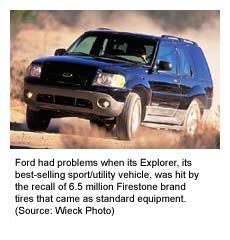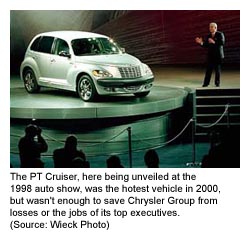|
Big Three at crossroads
|
 |
January 7, 2001: 8:00 a.m. ET
Gloom, plant closings prevails even as industry comes off year of records sales
By Staff Writer Chris Isidore
|
NEW YORK (CNNfn) - The auto industry limps into the North American International Auto Show this week, having just completed the gloomiest record sales year anyone could imagine.
Despite setting a record with 17.4 million cars and light truck sales in the United States, the talk this week centers on temporary plant closings, lowered sales estimates and earnings projections and whether the industry is already in the feared "hard landing" that marks a recession rather than just a slowdown.
"It was the best year as far as vehicles produced and sold, probably one of the worst in terms of corresponding profitability," said Brian Ambrose, national director of consultant KPMG's automotive practice.
This gloom comes even though most projections call for sales in the 16 million to 16.5 million range this year, which may be good enough to top every year's results other than the records set in 1999 and 2000. But even sales numbers in that range won't be enough to distract from problems facing the U.S. industry.
The traditional "Big Three" automakers - General Motors Corp. (GM: Research, Estimates), Ford Motor Co. (F: Research, Estimates) and the Chrysler Group of DaimlerChrysler AG (DCX: Research, Estimates) - all saw market share declines throughout the year, and will shut many of their North American plants for much of this month as they try to adjust for excess vehicle inventories. In fact even with a record sales year for the industry, GM and Chrysler saw sales fall from year ago levels, and Ford would also have lost ground if not for the acquisition of Volvo in spring of 1999 and Land Rover this past summer which helped skew year-over-year comparisons.
And while Toyota Motor Co., (TM: Research, Estimates) Honda Motor Co. (HMC: Research, Estimates) and many European and Korean automakers saw gains in sales the last year, even they expect a fall-off in sales this year.
"The economy is downshifting from delirious to deliberate and we have just passed a sign saying 'Proceed with Caution,'" said Jim Press, the executive vice president of the U.S. arm of Toyota. "Last year was great; this year will be merely good."
A year of wrenching change for Big Three
In addition, Ford and Chrysler are fighting to rebound from company-specific woes, and new leadership at GM is struggling to change the culture and overall structure of the behemoth that has often had trouble responding quickly to a rapidly-changing marketplace.
At Ford, the company was hit by a problem its officials still insist wasn't their fault - the recall of 6.5 million Firestone brand tires that were most commonly used as standard equipment on its light trucks, such as the Explorer, the industry's best selling sport/utility vehicle.
 The reports of at least 148 deaths related to the tire helped hurt sales of the Explorer, and exposed the company to legal liability. Firestone officials also insist that the design of the Explorer contributed to the tire's failure, a charge that Ford still denies. The reports of at least 148 deaths related to the tire helped hurt sales of the Explorer, and exposed the company to legal liability. Firestone officials also insist that the design of the Explorer contributed to the tire's failure, a charge that Ford still denies.
Still Ford agreed to pay close to $500 million of recall costs and is in the process of settling lawsuits from victims and relatives of victims. The company had to shut production for several weeks to free up replacement tires for the recall.
Click here for the a look at automotive stocks
It was also a traumatic year for Chrysler, as German leadership of parent DaimlerChrysler seized control of the company.
The three top North American executives at the Chrysler's Auburn Hills Mich. headquarters left the company, replaced by German executives pledged to cutting costs and restoring profitability.
The moves prompted other executive departures and reports of morale problems, as well as a series of shareholder lawsuits, led by one by Kirk Kerkorian, the largest U.S. shareholder, who charged fraud by company chairman Jurgen Schrempp at time of the 1998 merger of the two companies.
 The Chrysler Group reported a loss of 579 million euros, or $512 million, during the third quarter, and will soon report losses for the fourth quarter that are projected to continue into this year. This came despite the car maker having what was the hottest selling model of the last year, the PT Cruiser that staked new ground by blurring lines between car, S/UV and minivan. The Chrysler Group reported a loss of 579 million euros, or $512 million, during the third quarter, and will soon report losses for the fourth quarter that are projected to continue into this year. This came despite the car maker having what was the hottest selling model of the last year, the PT Cruiser that staked new ground by blurring lines between car, S/UV and minivan.
The changes at GM were perhaps less dramatic, but the company did report it would cut about 10 percent of salaried and contract employees in North America and Europe, and close several plants, in an effort to contain costs. The moves would cut about 14,000 jobs overall.
It also said it would discontinue the Oldsmobile brand, the nation's oldest car line, and take a $2.5 billion charge to handle all these changes.
New models pose more competition, lower prices
Despite all these company-specific challenges and problems, it was greatly hot new models from overseas competitors in such key segments as sport/utility vehicles, minivans and pickup trucks that ate away at profits of the Big Three.
Adding to these problems, pricing of new vehicles has been on a steady decline, as consumers have balked at paying more for some of the new options being debuted by automakers. While automakers say they are trying to deal with excess inventories through cuts in production rather than increased incentives, analysts say that can only go so far with 75 percent of the industry's cost fixed expenses that must be paid if they're making cars and trucks or not.
"Sales of 16 million now looks a lot less profitable than 16 million did a few years ago," said Rod Lache, analyst with Deutsche Banc Alex. Brown, who lowered his earnings estimates for the industry on Friday.
"The full benefit of the 18 million vehicle sales pace a year ago was never really achieved because of severe negative pricing over last couple of years. What's going to happen as auto demand decline you're not going to see pricing go up, you'll see pricing go down more."
Big Three vow a rebound
The automakers insist that things are not bad, that they will be well positioned for the current slump, and they're confident that sales will rebound from current levels to give them the volumes they expect and need.
"Our thought process is that this is truly the pause that refreshes. We expect to see improvement in the spring," said Paul Ballew, the general director, global market and industry analysis for GM. "Inventories are a bit higher than we'd like, but that doesn't mean we're treating it as a crisis."
Some other observers agree that the industry is not in a crisis, despite current talk of gloom and doom.
"We're likely to see what we would have called a soft landing six months ago. but as we got closer we got more scared of it," said Mike Flynn, director of office for study of automotive transportation at the University of Michigan.
Ambrose, despite concerns about the industry, agrees things are not as bleak as some believe.
"I think you're seeing a lot of very good quality cars throughout the industry," he said. "There is competition - what you have a is a very global marketplace and the best cars for the money are going to be purchased by the public. But if the Fed continues to reduce interest rates, the attractiveness of cars will increase again." 
|
|
|
GM shuts 12 plants later this month - Jan. 4, 2001
Big Three post big sales drop - Jan. 3, 2001
Ford cuts 4Q target, 1Q production - Dec. 21, 2000
Analyst says hard landing hitting autos - Dec. 15, 2000
GM cuts jobs, Oldsmobile division - Dec. 12, 2000
Auto sale fall hits profits, production - Dec. 1, 2000
GM cuts November sales target - Nov. 20, 2000
Daimler lowers Chrysler forecast - Nov. 17, 2000
Ford Explorer sales off - Oct. 31, 2000
|
|
|
|
|
|
 |

|

